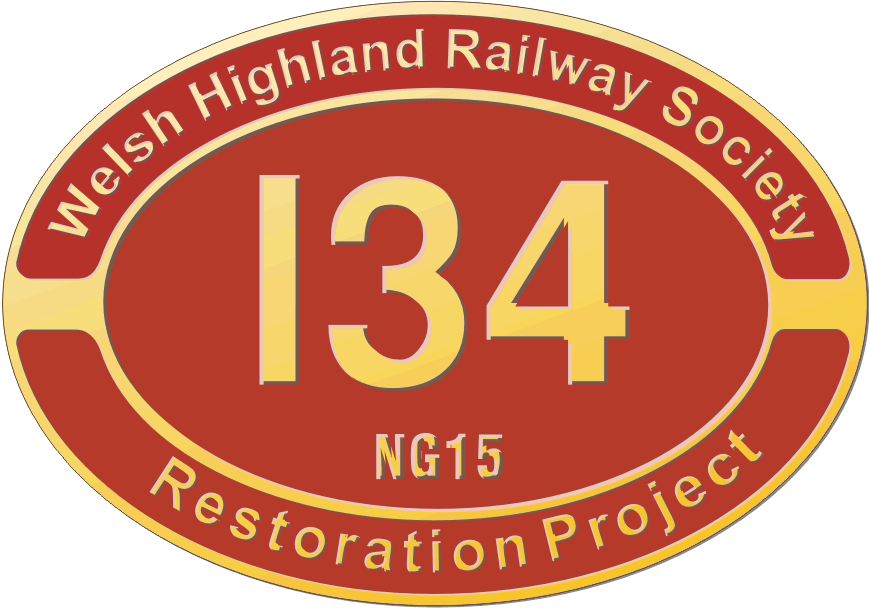
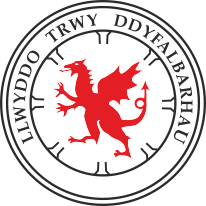 

|
 |
|
| Back to archived working party reports |
December 2011 Working Party Report
The December working party was held on the 17th & 18th of the month, the weekend before Christmas with the result that with the weather and the allure of the Christmas shops the Squad was somewhat depleted. The result was that for the first time in many years there were only two of us at Dinas over the weekend.
We carried on with the remounting of the handbrake on 133’s tender chassis. The brackets that we attached last time were drilled and a mounting plate made so that the pedestal could be bolted onto the chassis. With a new piece of footplating also bolted across the front of the chassis to allow safe operation of the brake, all the construction work was completed. All that needs to be done is the reassembly of the handbrake mechanism. The operating shaft which connects the brake pedestal with the brake rigging was still seized. With no easy solution available, the shaft and its bearings were unbolted and removed. This turned out to be a wise move as both the bearings turned out to be absolutely solidly seized to the shaft. The complete assembly was taken to the clip shed where we will attend to it next time!
A couple of photos are available in the Gallery.
It just remains to wish all a Happy Christmas, and remember the Tee Shirts are still available. (Donations too!)
November 2011 Working Party Report
This working part continued with the two task as described in previous working parties, the loco's frame alignment and №133's tender chassis.
Progress was finally achieved with the frame alignment in that we finally discovered that the driver's side cylinder, the replaced cylinder, has had it's liner incorrectly bored, it pointing away from the frames slightly. The fireman's side cylinder also points up slightly, again presumably from an incorrect rebore. A plan is to be generated to correct these two defects.
The work that Team Wylfa had done on the brake gear was all but completed with all the brake rigging reconnected and set up. Brake blocks were 'cottered' onto their shafts and adjusted to run true on the wheel treads. On Sunday, following liberal doses of easing oil, a large rose burner was applied to the main brake shaft bearings below the pillar and finally with the assistance of a 14lb hammer, the crank was finally freed off. It is still stiff – probably because one of the bearings is mounted on the back of the footstep which is easy to knock out of alignment being both flimsy and in an exposed position. A new bracket was then fabricated to take the hand wheel pillar. See the Gallery for a photo of this. The only things left to do now are to mount the pillar and connect to the freed off brake shaft, fit the vacuum brake piston rod and remount the vacuum brake train pipe between fore and aft. These are all possible after No.134's tender new tank is temporarily fitted.
Some other work also took place with the refurbishment of some minor components such as the removal of the old bushes from the break rigging suspension arms. The worn, rectangular suspension hanger rod holes on top of the chassis; were all chain drilled ready to be cut out, cleaned up and prepped ready for welding infill pieces in to restore the holes to true rectangles. This involved an awful lot of holes being drilled through metal in various states of hardness due to the years of modifications and welding. A drill on average lasted 1½ holes and this required one of the team being on permanent drill grinding duty on the Sunday!
September & October 2011 Working Parties Report
Both the the September and October working parties continued with the same two tasks of the previous months, namely that of the preparation of 133's tender chassis ready to receive the new tender body together with continuing with the loco frame alignment. The latter is proving particularly frustrating as it's proving very difficult to understand what's going on with the alignment. We certainly know we've odd cylinder castings and the replacement is misaligned but quite why we're not sure.
Regarding 133's rolling chassis, this is being refurbished so as to take the new tender body for №134 as it's own chassis still needs quite a lot of refurbishment work to finish it off. The new tender body was delivered to Dinas in time for the September working party and the HR Superpower weekend held the same weekend.
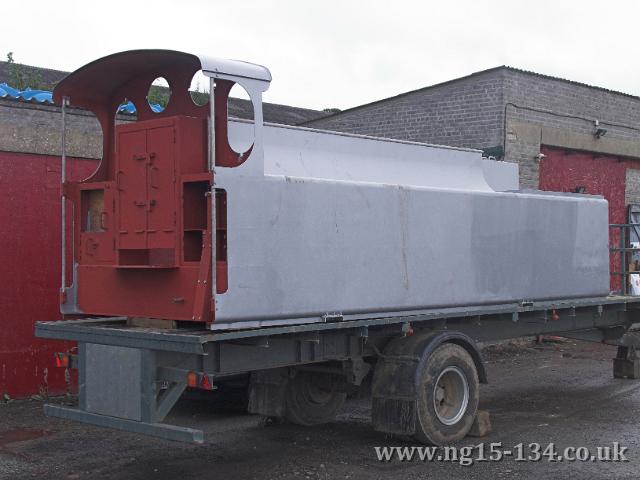 |
The tender body on display at Dinas during Superpower 2011
It is intended to use the new tender as a travelling advert for the restoration and to move it to prominant positions during special events.
The tender body was well received during the Superpower weekend that gave much encouragement to the team. Whilst there will be the objector to the new style those people must realise that we're in a different era and a different railway to that for which the NG15s were originally built. Never mind the fact that the old tender body was quite incapable of holding water anymore, quite simply, we would not be allowed to run tender first with the original tender with its poor rearwards visibility. This was OK in South Africa where the driver could swing out and with not a crossing in sight, but on the WHR with four or five crossing every mile and limited clearances a design such as this was unfortunately needed.
More details of the tender can be found in its own pages in the contract work section.
August 2011 Working Party Report
The working weekend got a lot done again. With two teams working simultaneously, one group tackled the frame alignment; while the other the basic refurbishment of 133’s tender chassis so it will be ready to accept the new body when it arrives. The main achievement was the fitting of FR/WHR standard couplings at each end, so that the vehicle can be easily towed. A refurbished vac cylinder out of 134 was also fitted so that it's now not too far off from being 'road worthy'. The main vac pipe was also removed for repair, overhaul and modification.
We have been working for a while to check the alignment of the frames (this is critical to ensure smooth running between the axles and the pistons). This had not been going too well, and this weekend we managed to confirm what we had been coming to suspect for some time, ever since we discovered that have unmatched cylinders and liners on each side. That is that the right hand cylinder is out of alignment by about 125 thou, 1/8“ or 3mm whatever your predilection. This in an ideal world, with full works facilities would mean that the cylinder would be removed and remounted on the loco having been re-machined and bored. This however would be a massive job for us and we are currently working out if we can rebore the cylinder to correct the alignment in situ. This is an accepted practice, but we are at the limits of the practicality for this process. The alignment issue is also at the back end of the cylinder, so the end cover with the piston gland in it will also need realignment! This is probably the biggest issue we have encountered since the restoration of the locomotive commenced.
Happily, the other cylinder and the other axles were all aligned and the driving axle datum dowelled in place. This will allow us to set up all the axleboxes, horns and suspension so we can re-wheel the engine.
At the Brunswick Iron Works, the monster is rapidly outgrowing its cage! Pictures show that the body in now well advanced and that the back of the cab has now been fitted. It is a truly magnificent piece of fabrication and hopefully you will all be able to see it soon. More details on the Tender page and in the Gallery.
Following the working party weekend, Team Wylfa had been progressing the de-scaling of 133's chassis during their evening working parties. Following this cleaning up they have now painted it to make it much more presentable and ready to receive the new tender body.
June 2011 Working Party Report
The June working party was planned as a long weekend with the Friday and Monday included to make up a four day session from the 24th June through to the 27th June. As it turned out Friday was well supported, as was the Saturday and Sunday, however by Monday the planned work was completed and numbers had thinned out a bit. Also on Monday and our lead engineer was called up to drive the service train so at that point it was decided the working party would be terminated.
The main area of work planned for the working party was the removal of all four tender bogies, those from under №134 and those form under №133. The intention being to select the wheelsets with best matched amount of wear on the tyres. So on the Friday the bogies were removed from under №133's tender in the Carriage shed.
This was followed on the Saturday by the removal of the door to the clip shed, a job that the group is becoming well versed in, followed by the wheeling out of №134's bogies from under the tender frames. With all wheelset alongside each other in the open air it soon became apparent that in fact the complete set from under №133's tender were in fact the best matched.
For more pictures of the working party go to the June working party page in the Gallery - click any of the pictures above.
On Sunday with the decision made as to the best matched wheelsets, №134's wheels were put back into №133's bogies. Before doing that however, the bogies had their spring gear freed up so as they will work correctly. The bogies were subsequently reunited with №133's tender frames. №133's wheels had their bearing surfaces protected and are now ready to be re-profiled for use on the WHR.
Alongside this activity the alignment of the loco frames continued throughout the weekend.
May 2011 Working Party Report
Rather than the May working party being held on the usual 3rd weekend of the Month it was moved back a week so as to coincide with the Railway's Rail Ale Festival weekend on the 21st & 22nd May.
After the success of the past few weekends this weekend unfortunately contained many frustrations and a rather disappointing amount of progress made. The hope was that we'd have completed the removal of the tender tank from NG15 №133, however, in being unable to find tools and equipment meant a lot of wasted time! Whist a start was made on the Saturday with a view of making do without some equipment, it involved more effort.
This work did, however, finally get underway on the Sunday when we managed to track down the kit that was needed. Unfortunately some of the 'workaround' progress meant that doing the work as originally intended now took longer. In all it probably took a day and a half to do do what should have taken 3/4 day. These frustrations come along and thwart us occasionally and we just have to ignore them and get on as best we can.
Other work progressing this weekend included, the continuation of the frame alignment jig work. The piano-wire reference wire was further aligned, although it is felt some modifications are needed. It's likely this will now be left until other work needed on the frames has been finished so as it does not disturb the jig alignment. The fitting of the running boards continued. This requires the drilling of holes into the newly fitted edge angle to match those already in the platework. This job has also been progressed by Team Wylfa in between the regular Monthly working parties.
On the tender, the removal of the front dragbox casting continued. The removal of this is getting a bit 'long winded' and Ben, our volunteer working on it, will be glad to see than back of the job!
April 2011 Working Party Report
The April working party took place over the weekend of the 16th & 17th. The jobs were a continuation of those of the past few working parties and apart from one 'destructive' task were all associated with the re-construction of №134.
The destructive part of the weekend was the cutting up of №133's tender body. This had been deemed in poor condition many years ago and has certainly not got any better with age! The main body was full of holes and all the internal baffles were so rotten they could be pulled out by hand! This now leaves the tender chassis that will be tided up in order to act as temporary storage for №134's new tender body when it arrives from Brunswick Ironworks later in the year.
With №133's tender body now removed the opportunity will be taken to do wheel swaps so as to match tyre wear between the two tenders. №134's wheelsets were in various states of wear and so it is intended to try and match them as best as possible. This should enable us to maximise wear out of all tyres, including those under №133's tender should that loco ever reach the head of the restoration queue.
As regards №134's tender chassis, work continued on the removal of the front drag box coupling casting for reuse in the new dragbox that will be built.
As well as the work on the tender, another group was concentrating on the loco frames with the main area of activity as in previous months being centred around the cylinder and frame alignment. We have been set back by approximately 4 months on this due to the discovery that the loco has mismatched cylinders. At some point in its career it's been given a replacement cylinder and so there are some dimensional discrepancies that will need to be allowed for. To find out which one is the original will need some more research. The result of all this is that spending more time on getting it right now will save us time in the long term.
Also
on the loco frames work continued on welding up the horn ties to
prevent the frames from cracking. The ties should be a tight fit over
the horns but in some cases are very loose.
One of the 'indirect' jobs was that of another session of jig making. This time it was the manufacturing of clip press tools for the copper lubrication pipework. Some clips were subsequently manufactured using the new press.
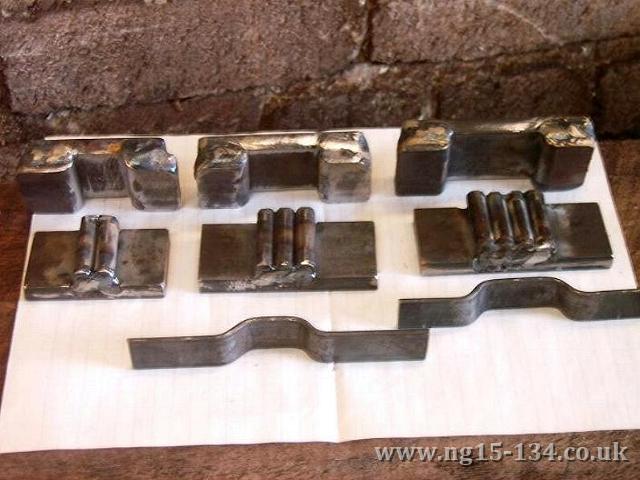 |
As always there are more photographs in the Gallery section.
In all another productive weekend was had. There's now also a varied group of people rainging from a young Welsh lad, a Polish guy and a South African (who claims to be English as he was born on Colonial land) through to various people from the South of England up to Lancashire.
March 2011 Working Party Report
With 10 people attending on the Sunday of the March working weekend the team were able to work of 5 different projects at the same time.
The first project was that of fitting the piano wire through the cylinder to check for squareness. This is a long term task that will be continuing for a few more weeks to come.
The
second was the painting of the tender's rear drag box. This had been
repaired and strengthened over the past few weeks and now that
all
the welding was finished painting could commence.
Following the
removal of the tender's front drag box one group
concentrated
on the removal of the draw bar location plate from the draw box. This
will be reused later in the new drag box with the old
front
drag box being beyond economical repair.
The fourth project was
a start being made on the scraping the old tender tank from
133.
It is intended that when the new tender turns up in late
summer it
will be placed on 133's tender chassis whilst 134's chassis is finished
off.
Finally the welding repair work continued on the horn ties on the loco
frames.
As
usual there are some photographs in the Gallery
section. These show the scrapping of 133's tender tank, the frame
alignment and the repaired rear tender drag box.
February 2011 Working Party Report
A good regular group now attends these working parties and on this occasion they were joined by a new young local volunteer. As is the trend of recent working parties, the group was active on both the tender and loco.
The main activity on the tender concentrated around refitting the break cross shaft. This has been cleaned realigned and greased so as it can now be turned quite easily by hand.
On the loco, work commenced on the refitting of the running boards and this involves the laborious job of drilling the hundreds of holes in the new running board angles. The alignment of the frames was also the centre of attention, continuing from the previous working party. During this activity it was discovered that the wheels have been moved forward by 0.150” (or 3.5mm in modern parlance!) and as a consequence the loco had been fitted with shorter piston rods. The manufacturing continued of a jig that is needed to align a wire through the centre of the cylinders to check the frame squareness. Another set of jigs was also started that will be used to manufacture all the clips to attach the lubrication pipework to the engine at a later date.
With the weekend having no dismantling or removal of bits of engine, and consisting of much refitting of components there was a warn feeling of the loco coming back together again. There was a real sense of having 'turned the corner' in the restoration of №134.
As always a few photos from the weekend are in the respective section of the Gallery.
January 2011 Team Wylfa Report
Here Clive Briscoe gives an update of the valuable work done in the evenings by Team Wylfa. If you are unable to make our Monthly working party weekends but find yourself at a loose end in the area on weekday evenings and can help then Clive would be interested in hearing from you. Details on the Contacts page.......
With
the carriages now tucked up in bed until the start of the new season,
Team Wylfa have been able to step away from them and work full time on
134 during their regular Tuesday evening working parties. Since before
Christmas, there's been slow but steady progress in between the monthly
134 Group working parties.
The main thrust has been on the
removal for replacement of some of the rivets holding the rear of the
loco’s frames together in the firebox region. Some of these rivets had
badly wasted heads on the inside of the frames where they were adjacent
to the firebox. It’s quite a challenge as the rivet material is very
tough and resists drilling. It’s taken its toll on our stock of ¼”
pilot drills – several of which have now been reground so many times
that they are now mere stumps. Then there’s the larger drills - ½” and
larger which are also diminishing… It is necessary to go up to c.¾” for
approx half way through so that 1) A large punch can be inserted which
will not distort or jump out when struck with a 14 lb hammer and 2) So
that the rivet will slightly give (reduce in diameter) on each hammer
blow. Eventually, they do come out but so far, have been resisting
until the last few thou! After each rivet has been taken out, a
temporary nut and bolt has been fitted to stop the laminations of the
frames from coming apart.
Unfortunately, there is more drilling
of rivets in the offing – almost certainly, the loco’s internally
corroded rear drag box will have to come off for rebuilding (like the
tender’s front dragbox which was removed during the recent January
working weekend).
Also being produced at the moment are
replacement studs for the tender’s vac pan fittings. Once the vac pan
is finally in place, the next task will be to rig the brake gear. Most
of the rods and fittings were worked on in earlier phases of the
restoration a few years ago though most are currently waiting on a
pallet for NDT checks before they can be re-fitted. There is something
of a push on to complete the tender chassis work asap since a new
tender tank / bunker is a distinct possibility before too long and it
will need somewhere to sit when it arrives. And where better but its
final resting place…
Anyone in the N Wales area fancy joining
us? Let me know beforehand - see my contact details on the main WHR
website www.whrsoc.org.uk/WHRProject or Barrie's website
www.isengard.co.uk or on the 134 dedicated website
http://ng15-134.co.uk. We're there from 7 - 10pm. If it's known that we
won't be there for whatever reason, a look on Barrie's site under the
‘Team Wylfa’ banner will usually reveal a post to this effect a day or
two beforehand.
The 500 day challenge to beat Wilf Mole's 136
restoration team (Lukas et al in their Bloemfontain workshops) is now
ticking away so the more folk we have working on 134 the better if we
want to try and beat Lukas and the Sandstone Team in bringing 134 back
into steam ahead of their 136...
January 2011 Working Party Report
We had a good turnout for the first working party of 2011 with plenty of tasks being worked on on both the loco and tender. With the tender, the bulk of the heavier work being done that weekend was the removal of the front drag box from the frames. As indicated by its name, with this being a box structure, and with a number of integral casting, we we’re unable to establish the condition of some of the internal sections. This therefore entailed its removal and so this was started on the Saturday and completed on Sunday. The result of this exercise being that the drag box will require renewal!
Work continued with the tender vacuum pan with the tapping for the studs in the neck ring and the chamber side release. Also on the tender, shimming and aligning the tender brake beam was done so that it rotates by hand.
On the loco itself the main tasks were associated with checking the alignment of the frames. This has involved the manufacture of various jigs, with some machining completed on the Saturday, to enable measurements to be taken. Although there is more to be done, the measurements taken so far indicated nothing untoward other than a difference in the cylinder lengths. We are aware that we have odd cylinders, ie one casting has been replaced at some time in the loco’s life such that we have a slight difference in the front to rear faces of the cylinder bores.
Finally there was the painting - there's always painting to be done! The aim is the fit the running plates as soon as possible so all the plate sections and edge angle are being painted prior to fitting. This has also involved the slight adjustment to the mounting of one of the running plate frame hangers as this had distorted slightly whilst having some butchery repaired.
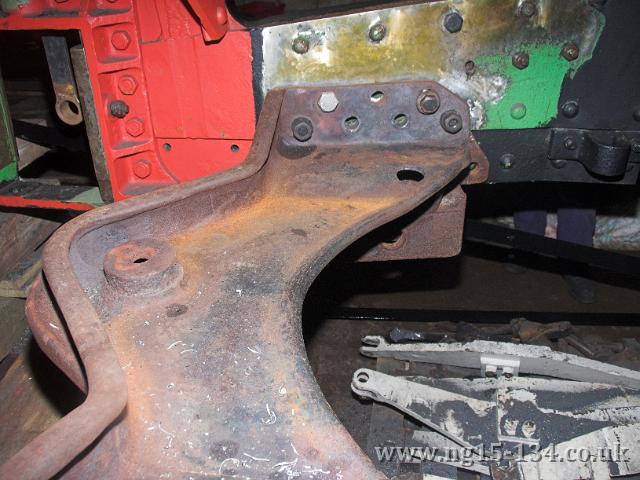 |
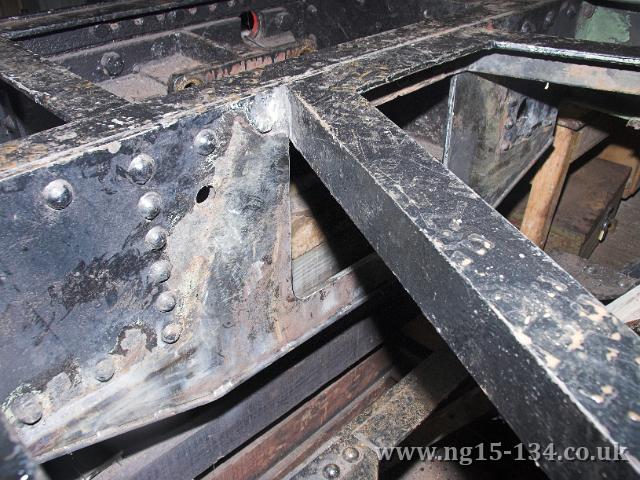 |
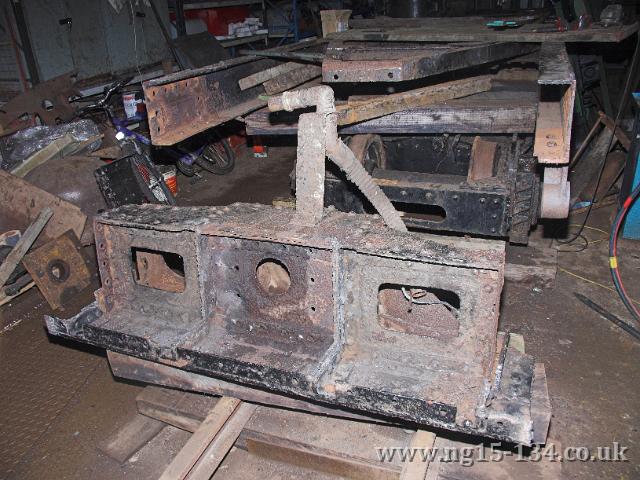 |
Many more pictures are in the Gallery - click any of the pictures above.
Back to the Archive